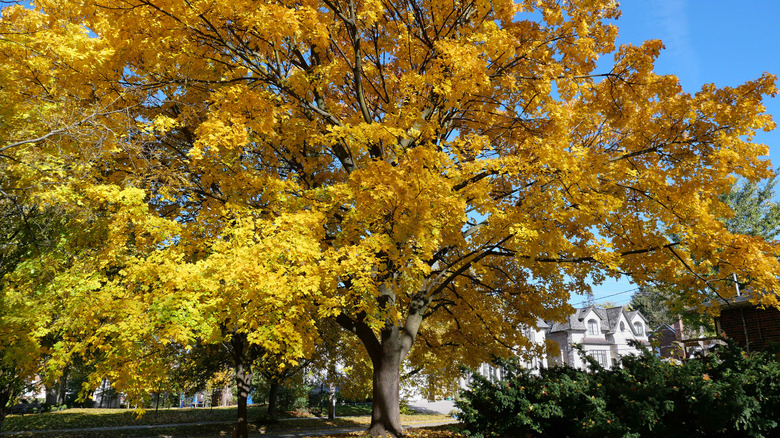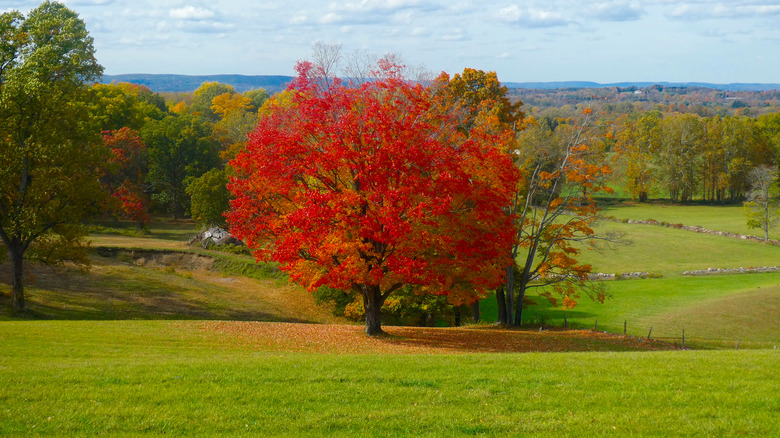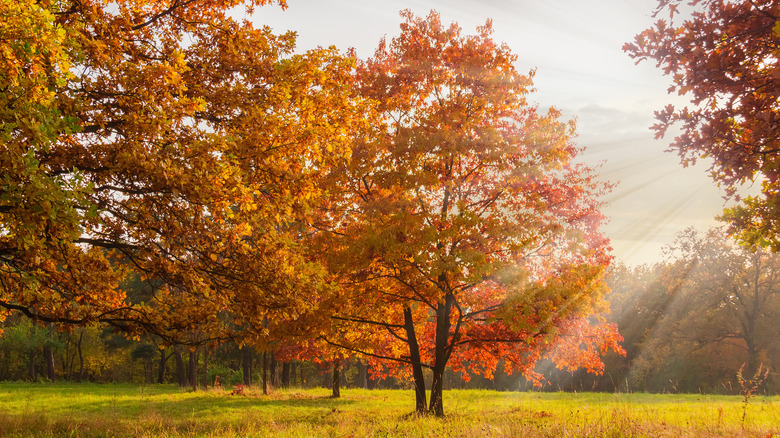Good Alternatives To The Invasive Norway Maple Tree
The Norway maple is a towering, beautiful tree introduced to the U.S. in the 1700s. Since then, it has grown and spread throughout North America. In many ways, it has become an invasive plant — One that can be hard to control once present. If you love the look and ease of caring for this tree but hate that it's overtaking your yard, you can choose alternative options, including the sugar maple, American Linden, Red Maple, and White Ash trees. These trees offer many of the same benefits but are less invasive plants than the Norway maple, with a bit more control over the germination process.
A number of factors have helped the Norway maple to do well, including that it's very fast-growing, reaching 40 to 60 feet within a matter of years. It can thrive like that because it's both drought and heat-tolerant and capable of thriving even in sandy or clay-based soils. This gives it an advantage over other trees and plants that need access to richer nutrients or tend to struggle under the difficulties of extreme weather conditions.
Since its introduction to the region centuries ago, the Norway maple has changed the look of many regions and altered the ecosystem a bit as well. Not only does it grow tall very quickly, but it also has rich foliage that blocks other plants nearby, often starving those plants of the nutrients and sunlight they need. When it's time to go, there are options.
Consider other maple trees
As an invasive plant, the Norway maple can be replaced in many regions with several other maple tree varieties, specifically the sugar maple and the red maple, both of which offer the same beauty overall with a few key benefits. Both maples are native to North America and have long been present within the local ecosystem.
The sugar maple tree is a hardwood tree that does well in many regions. It is shade-tolerant and performs well in slightly sandy soils. It's also easy to grow, requiring very little hands-on support or trimming. These trees grow tall, often reaching 80 feet tall, but within the first ten years, they are only likely to grow to 15 to 20 feet, making them easier to fit into a denser space. They don't have the same thick foliage either, which means companion plants can grow nearby and still do well. They are also stunners when it comes to fall color.
The red maple, as its name implies, has a redder tone to its leaves, especially in the fall months. It's also fast-growing, but they do well when planted in a dense forest. Most will grow about a foot or so per year, reaching as high as 80 feet tall over time. This tree has brilliant displays of fall colors but also doesn't eat up too many of the nutrients from the surrounding area, allowing it to work well with other plants nearby.
Other plant alternatives to Norway maple
You don't have to stick with maple to get a hardy, beautiful tree to replace a Norway maple. Consider a red oak, for example. Red oaks can reach over 100 feet tall, making them some of the largest trees in the area, and they also have a wide canopy of leaves that can stretch to 50 feet or more. This does create a dense shaded area under them, but these trees are still very easy to grow and don't germinate and spread nearby as quickly as the Norway maple.
Next, think about the American linden, a beautiful tree that grows slower than most maples. It does best in full sun but can tolerate most types of soil conditions. They can reach about 60 feet into the sky, and the trunk tends to be very straight. They tolerate most environments well and are not rapid reproducers like the Norway maple, allowing you to remain more in control over their spread.
A final alternative to the Norway maple is the white ash, a stunning, easy-to-grow tree that can reach well over 100 feet tall. It does best in well-drained but moist soils and becomes more at risk for disease when conditions are wetter. This tree is easy to transplant, but it's not nearly as invasive because it doesn't seed quickly or easily, giving you more control over the trees in your backyard. These alternatives to the Norway maple still offer shade, beauty, and fabulous fall color.


